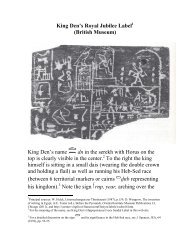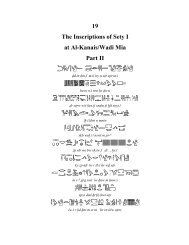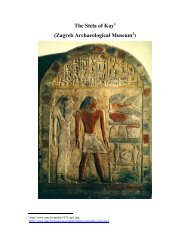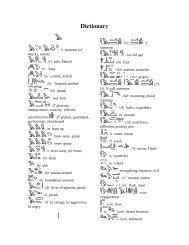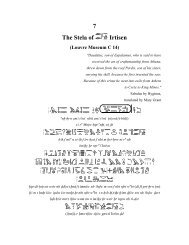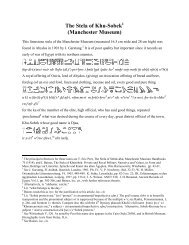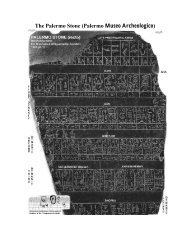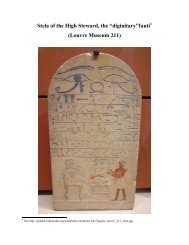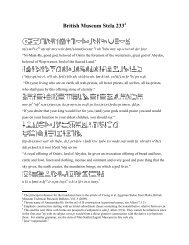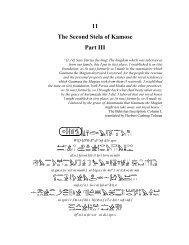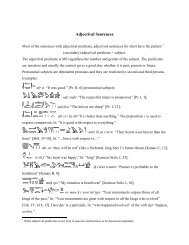17 The Bull Hunt Scarab of Amenhotep III - Middle Egyptian ...
17 The Bull Hunt Scarab of Amenhotep III - Middle Egyptian ...
17 The Bull Hunt Scarab of Amenhotep III - Middle Egyptian ...
Create successful ePaper yourself
Turn your PDF publications into a flip-book with our unique Google optimized e-Paper software.
mSa “ the common soldiers,” lit. “the citizens <strong>of</strong> the army,” and Xrdw n kAp “the children<br />
<strong>of</strong> the kap/nursery.” Note that in some 18 th Dynasty writings kAp resembles a wrist<br />
and hand. <strong>The</strong> attached apparent adjectives r Dr.f and mi qd.f emphasize that the entire<br />
army with all its attachments was present. Finally, the pseudoverbal r + infinitive<br />
construction expresses the planned action rsw Hr to watch over/guard the wild cattle (with<br />
rsw in the infinitive used as a noun).<br />
ist wD.n Hm.f rdit itH.tw nn smAw m sbti Hna Sdy<br />
<strong>The</strong> particle ist marks the adverb clause in which the king commands (in circumstantial<br />
sDm.n.f /perfect) to drive the wild cattle into a walled enclosure with a ditch. <strong>The</strong><br />
command itself employs the rdi + prospective/subjunctive sDm.f construction with rdi (as<br />
the object <strong>of</strong> wD) itself in the infinitive. Notice the (suddenly) missing genitival adjective<br />
n after nn in the plural demonstrative, a practice that started before the 18 th<br />
Dynasty.<br />
In Thuthmose <strong>III</strong>’s siege <strong>of</strong> Megiddo we can read<br />
i[H] m Sdy inH m xtw wADw n xtw.sn nb bnr 5 . <strong>The</strong><br />
<strong>Egyptian</strong> army surrounded the town with a ditch and walled it up (with new timber from<br />
fruit trees). As Breasted pointed out, the situation and the choice <strong>of</strong> the words iH<br />
“surround, net, catch,” Sdy “inclosure, ditch,” and inH “wall” are<br />
reminiscent to ours here. While the situation is analogous, it is not the same. <strong>The</strong> static<br />
meaning <strong>of</strong> the verb inH should be contrasted with the dynamic meaning <strong>of</strong><br />
itH, and it is more likely that the wild cattle were driven (drawn) into a walled<br />
enclosure (with a ditch) rather than surrounded by a wall.<br />
wD.in Hm.f r nn smAw r Aw.sn<br />
5 [Urk. IV, 660, 15-6].



